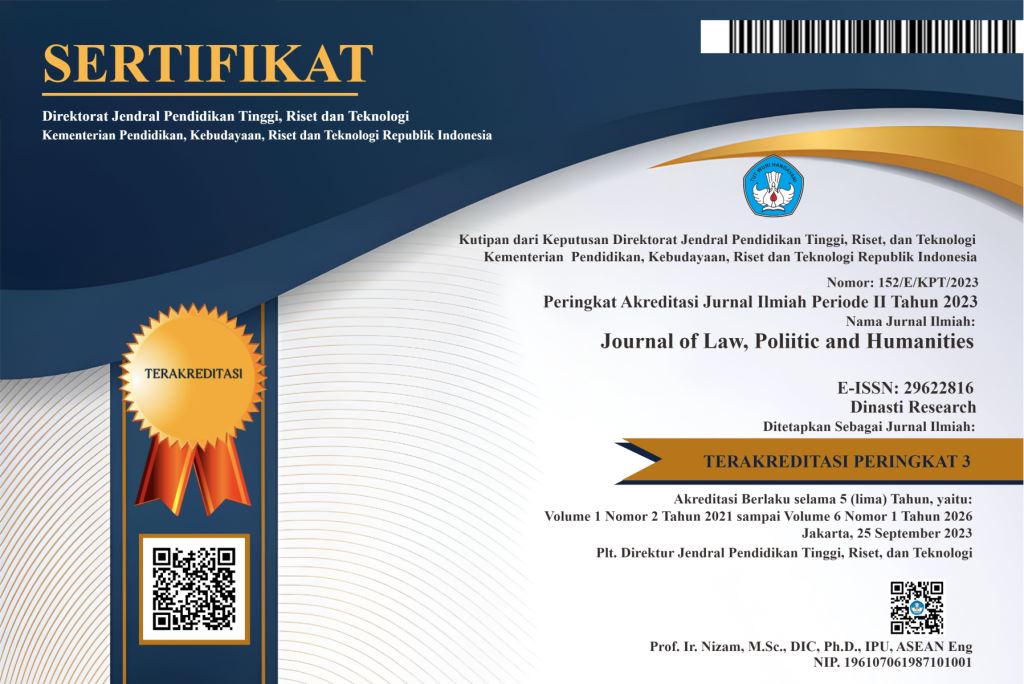The Consequences of the Mixed Marriage Law Reviewed from Law No. 16 of 2019
DOI:
https://doi.org/10.38035/jlph.v6i1.2441Keywords:
Keyword: mixed marriage, citizenship, Marriage Law.Abstract
Marriages between Indonesian citizens and foreign nationals have become more prevalent in the context of globalization. This research examines the legal framework governing mixed marriages under Law Number 1 of 1974 on Marriage and its amendment through Law Number 16 of 2019, alongside its connection to Law Number 12 of 2006 on Citizenship. Employing a normative juridical approach, the study analyzes the requirements for entering into mixed marriages, the procedures for their official registration, and the resulting legal implications for the spouses and their children. The study finds that a notable amendment in Law Number 16 of 2019 is the unification of the minimum marriage age to 19 years for both men and women, which has implications for the validity of mixed marriages when the foreign spouse’s national regulations differ. Additionally, proper marriage registration, whether within Indonesia or abroad, is essential to secure legal recognition and protect the rights of all parties involved. Children from mixed marriages are entitled to limited dual citizenship under Law Number 12 of 2006, valid until they turn 18 or marry, at which point they must choose one nationality. The study underscores the significance of legal certainty through marriage registration and the alignment of national, religious, and international laws to safeguard the rights of couples and their offspring.
References
Dewi Iriani. (2015). “Analisis Terhadap Batas Usia Pernikahan Dalam UU No. 1 Tahun 1974”. Justitia Islamica. Vol. 12, No. 12.
Herni Widanarti. (2019). Tinjauan Yuridis Akibat Perkawinan Campuran Terhadap Anak. private law review. Vol. 4, No. 1.
Hill Napoleon. (1982). Pedoman Dalam Perkawinan. Bandung: Indah Jaya.
Junaedi Karso. (2021). Perkawaninan Campuran & Kesejahteraan. Bantul: Samudra Biru.
Laurensius Mamahit. (2017). Hak Dan Kewajiban Suami Isteri Akibat Perkawinan Campuran Ditinjau Dari Hukum Positif Indonesia. Lex Privatum. Vol.I/No.1.
Peraturan Pemerintah Nomor 9 Tahun 1975 tentang perkawinan
Reggie, Baay. (2019). Perkawinan pribumidan Eropa dimasa colonial. Depok: Komunitas Bambu.
Reggie, Baay. (2017). Akar Sosial Dari Perkawinan Campuran Di Masa Lalu, Yang Tidak Selalu Berdasarkan Relasi Setara. Depok: Komunitas Bambu.
Rinjani Bahri. (2017). Komunikasi Lintas Budaya, Kota Lhokseumawe: UNIMAL PRESS.
Simanjuntak. (2015). Hukum Perdata Indonesia. Jakarta: Prenadamedia Group.
Soerjono Soekanto & Sri Mamudja. (2001). Penelitian Hukum Normatif (Suatu TinjauanSingkat). Jakarta: Rajawali Pers.
Subekti, R. (2009). Hukum Perkawinan. Jakarta: Intermasa,
Syarifuddin, A. (2006). Hukum Perkawinan Islam di Indonesia: Antara Fiqh Munakahat dan Undang- Undang Perkawinan. Jakarta: Kencana Prenada Media Group.
Undang-Undang Nomor 62 Tahun 1958 tentang Kewarganegaraan Republik Indonesia
Undang-Undang Nomor 1 tahun 1974 tentang perkawinan
Undang - Undang Nomor 12 Tahun 2006 tentang Kewarganegaraan
Undang-Undang Nomor 24 Tahun 2013 tentang administrasi kependudukan
Undang-Undang Nomor 16 tahun 2019 tentang perkawinan
Downloads
Published
How to Cite
Issue
Section
License
Copyright (c) 2025 Zaidan Lukmanulhakim, Deni Guntara, Muhamad Abbas

This work is licensed under a Creative Commons Attribution 4.0 International License.
Authors who publish their manuscripts in this journal agree to the following conditions:
- The copyright on each article belongs to the author(s).
- The author acknowledges that the Journal of Law, Poliitic and Humanities (JLPH) has the right to be the first to publish with a Creative Commons Attribution 4.0 International license (Attribution 4.0 International (CC BY 4.0).
- Authors can submit articles separately, arrange for the non-exclusive distribution of manuscripts that have been published in this journal into other versions (e.g., sent to the author's institutional repository, publication into books, etc.), by acknowledging that the manuscript has been published for the first time in the Journal of Law, Poliitic and Humanities (JLPH).


























